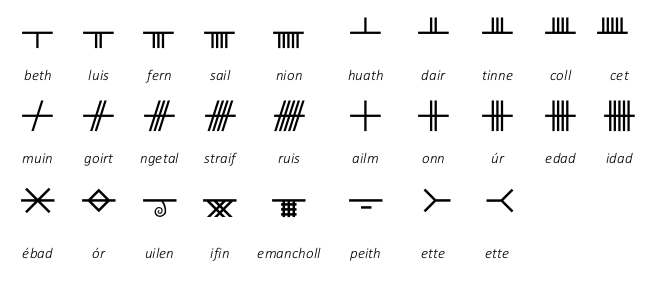An diofar eadar na mùthaidhean a rinneadh air "Scribes, Shorthand and How to Save on Parchment"
| Loidhne 8: | Loidhne 8: | ||
The names have changed slightly since (we're talking 5-6th century AD here) so here's another list of what we think the sound values of the above letters were, what the names mean and what their modern counterparts are (the last series doesn't have tree names): | The names have changed slightly since (we're talking 5-6th century AD here) so here's another list of what we think the sound values of the above letters were, what the names mean and what their modern counterparts are (the last series doesn't have tree names): | ||
| − | + | {| class="wikitable" | |
| − | {| | + | |- |
! align="left" | Ogham | ! align="left" | Ogham | ||
! align="left" | IPA | ! align="left" | IPA | ||
Mùthadh on 00:09, 2 dhen Dàmhair 2013
Most of you have probably heard of Ogham, [oɣəm] in Gaelic and [oːm] in Irish, and seen the Uncial script still used (mainly) in Ireland for ornamental purposes. We'll have a look at all that and especially a few tricks from medieval scribes which can help you write Gaelic more quickly when you're in a rush.
Now, Ogham. It represents the earliest writing system in which Goidelic was written. We'll not go into who invented it. It consisted of strokes, dots and other shapes carved on the faobhar (edge) of not-so-easily carried items such as slabs of stone and sticks of wood. Who can spot the drawback? Anyway, here's the most commonly found symbols:
Whoever named these decided to name them after trees, hence all the talk about the tree-alphabet. They are arranged differently i.e. the letters, if grouped according to their basic shape do not end up in the a b c order which we are so used to (basically because the a b c order was borrowed from the Romans who had borrowed it from the Greeks who had nicked it from the Phoenicians who had picked the brains of some Semitic tribe). Why this particular order isn't obvious, it doesn't seem to have a phonological background the way Korean Hangul has except that all the vowels are in one group ... anyway, we'll put it down to too much sitting in stone huts with stones on your chest.
The names have changed slightly since (we're talking 5-6th century AD here) so here's another list of what we think the sound values of the above letters were, what the names mean and what their modern counterparts are (the last series doesn't have tree names):
| Ogham | IPA | Irish | Gaelic | Gaelic IPA | Meaning |
|---|---|---|---|---|---|
| beth | b bj | beith | beith | [beh] | birch |
| luis | L lˠ Lʲ l | luis | luis | [Luʃ] | rowan |
| fern | f fj | fearn | feàrna | [fjaːRNə] | alder |
| sail | s ʃ | sail | sail | [sal] | willow |
| nion | N nˠ Nʲ n | nuin | nuin | [NuNʲ] | ash |
| huath | h | uath | uath | [uəh] | whitethorn |
| dair | d dʲ | dair | dair | [darʲ] | oak |
| tinne | t tʲ | tinne | teine | [tʲenə] | holly |
| coll | k kʲ | coll | coll | [kɔuL] | hazel |
| cert | kː (?) | ceirt | ceirt | [kʲeRʃdʲ] | crab apple |
| muin | m mj | muin | muin | [muNʲ] | vine |
| goirt | g gʲ | gort | gort | [gɔRʃdʲ] | ivy |
| ngetal | ŋ ŋʲ | ngéadal | ngeadal | [ŋʲedəL] | broom |
| straif | z | straif | straif | [sdraf] | blackthorn |
| ruis | R Rʲ(?) | ruis | ruis | [Ruʃ] | elder |
| ailm | a | ailm | ailm | [alam] | elm |
| onn | o | onn | onn | [ɔuN] | gorse |
| úr | u | úr | ùr | [uːr] | heather |
| eadad | e | eadhadh | eadha | [ɛɣə] | aspen |
| idad | i | íodha | iodh | [iɣ] | yew |
| éabad | ea | éabhadh | èabhadh | [iəvəɣ] | |
| or | oi | ór | òr | [ɔːr] | |
| uilen | ui | uileann | uileann | [ulaN] | |
| ifin | ia / io | ifín | ifinn | [ifɪNʲ] | |
| eamancholl | ae | eamhancholl | eamhancholl | [ɛvanxɔL] | |
| peith | p pj | peith | beith bhog/peith | [be vog] [peh] | dwarf elder |
Sooo ... easy things first. The two ette symbols in the picture which aren't in the list are called ite 'feather' and ite thuathail 'reverse feather' and were usually placed at the beginning and end of a line of squiggles.
Now, a single letter was called a feadh 'a few' (Old Irish fid) (cf modern feadhainn) and a whole category an aicme 'a race' and they are named after the first letter in that group, so you get beith aicme etc. Originally there were only 4 groups, the fifth and sixth, called the iar-fheadhainn 'extra ones' (Old Irish Foirfeda) were added later.
Note how p stands out as an oddball too, which we all expect of course since we know that Goidelic lost Indoeuropean p early on.
Do you know the most annoying thing about all this? Gaelic is one of the few languages of Europe which had not only their own alphabet with its own order but also names for all the letters, yet 20th century "educationalists" have decided to completely ignore this wonderful resource and insist we spell Gaelic and Irish the English way. Why? Beats me. Fear of our own heritage I suppose. Just think, our own Alpha Bravo Charlie and we're not using it ...
After a few unsuccessful attempts by Queen Meabh to send her husband out with a slab of a shopping list this system was abandoned when monks introduced Latin writing. Which is actually unfair because there are a few isolated incidents of Ogham in manuscripts, so it could have been adopted for writing on vellum obviously. But it wasn't.
We've discussed the genius behind the system elsewhere already, so we'll ignore that and have a look at this business of shorthand straight away. This system used 18 letters from the Latin alphabet and a few diacritics and quite a number of abbreviations (because vellum or parchment was expensive, really expensive):
The accented letters are nothing new to all of us. The first new-old bit is the bottom row. When it was first written, lenition wasn't always shown in the writing as everybody who wrote Irish could speak it and thus it could easily be inferred from the context or knowledge of the language. Ingen 'daughter' for example was pronounced [in̻ɣen], as if it were spelled inghean. When people began to mark lenition consistently, they didn't stick an h in (for the most part) but just put a dot over the consonant to show it was lenited. Saved space and even allowed you to "update" texts long after they were written. Manuscript writers in Scotland used this system up until the 18th century (there's a document in the National Library of Scotland for example which is signed William Mc̄ ṁuracħ - William MacMhurchaidh) and it was the norm in Ireland up until the Second World War.
Then some Irish civil servants got their hands on it and decided to replace it with "normal" letters and abolished the sèimheachadh symbol, or séimhiú as the Irish call it, with an h at the same time. Which made every written or printed text about 1/3 longer ...
Oifig an tSoláthair Baile Átha Cliath
So ... first thing you could use when writing in a hurry - replace every h that stands for lenition with a dot above the consonant. Note also that the Gaelic ı strictly speaking has no dot, so there's another opportunity to save on your ink: sèıṁeaċaḋ ...
But the old scribes had more tricks in store than just a dot. Here's a few more of their most common shorthand symbols:
So what do we have? Apologies for the old fashioned font, I couldn't find a modern one that has Old Irish abbreviation symbols! A fused rr for a double rr, a tilde over a vowel to show m, a tilde plus a dot for mh, a macron for an n, double for double nn, a macron with dot for any vowel + bh, dh or gh, an a with a descender and little stroke for ar, two strokes for double arr, a with a descender and ascender and little stroke for air, i with a descender and stroke for ir and the thing that looks like a long r with a bar to stand for achd or chd.
The last one is my favourite, the so called agusan [ag̊əsan] or "Tironian ampersand". It's an old abbreviation for and which was used for a long time throughout Europe until the & symbol bounced back. The only people left using it in the 20th century were the Gaels and it's a really handy symbol as it involves a lot less struggle than the & symbol.
Obviously not all of these symbols are 100% adequate for modern "shorthand" but quite a few of them might come in handy.
Incidentally, a full shorthand system was devised for Gaelic in the 1880's but never seems to have reached a wide audience. Watch this space, we might present it at some point.
| Beagan gràmair | ||||||||||||
| ᚛ Pronunciation - Phonetics - Phonology - Morphology - Tense - Syntax - Corpus - Registers - Dialects - History - Terms and abbreviations ᚜ | ||||||||||||


